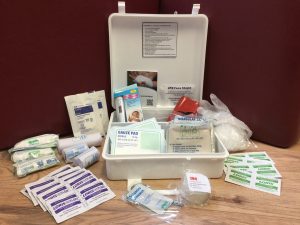Description
The benefits of doing first aid training on line
All teaching and educational institutions now use e-learning as a teaching tool. Forméduc is no exception and puts new technologies at the service of its clients.
- Online training is done at your own pace. Unlike 6 hours of continuous training where you are given all the information, the online course offers the opportunity to cover each chapter when you are ready to study and to move on to the next one when it is well integrated. This helps to consolidate what you have learned and increase your sense of competence.
- Each section of the training ends with a questionnaire and a recapitulation of the material, to allow you to validate your knowledge.
- The training document is very, very comprehensive! It has 14 sections. Each section is extensively illustrated and the techniques are supported by video clips, which you can view as many times as you like.
- The training document has a table of contents and a table of manoeuvres to help you quickly and easily find the section or technique you are looking for.
- The content of the training is in accordance with ILCOR (International Liaison Committee On Resuscitation) guidelines.
- The online first aid training allows you to see and review the techniques at will, without having to wait 3 years or pay again to attend the training.
- Although the training is done online, pedagogical support is available as needed.
- Once the training is completed, the participant is redirected to an automated platform to take the exam. 3 attempts are granted for the exam. Upon successful completion of the exam, the participant automatically receives the score, feedback and an electronic certificate by e-mail. Cards are no longer routinely mailed. Participants who wish to receive a card by mail can request one by email and it will be sent to them free of charge. The client has a period of 6 months from the date of order to complete the process.
- Lost or damaged card: You may request a reprint of the certificate. A fee of $10.00 per certificate is applicable.
- The certificate conforms to the standards of the Ministère de la Famille and the endorsements required by section 51 of the Regulation respecting educational child care services (R.S.Q., c.S.4.1.1, r.2) are inscribed on the certificate:
Training adapted to early childhood
Management of severe anaphylactic-type allergies
Duration of 6 hours
Overview of the content of this training:
- Injury prevention
- Infection control
- Managing an emergency situation
- Assessing an emergency situation
- Respiratory emergencies
- Severe allergic reaction (anaphylaxis)
- Cardio-respiratory emergencies
- The wounds
- Head and spine injuries
- Shaken Baby Syndrome
- Musculoskeletal injuries
- Medical emergencies
- Cold and heat emergencies
- Poisonings
- Early childhood diseases
- Prevention of child maltreatment
Representative video sequences of the updated techniques included in the training document.
Following the training, participants will be able to :
- Comply with safety regulations and protective measures.
- Assess an emergency situation in order to make appropriate decisions.
- Take charge of the child’s condition.
- Recognize and differentiate the signs and symptoms present in various situations.
- Apply resuscitation interventions and interventions specific to the child’s health problem.
Pass mark required: 60%. If you fail, we will send you another exam.
Would you like to know more about this course? Please contact us for more information







